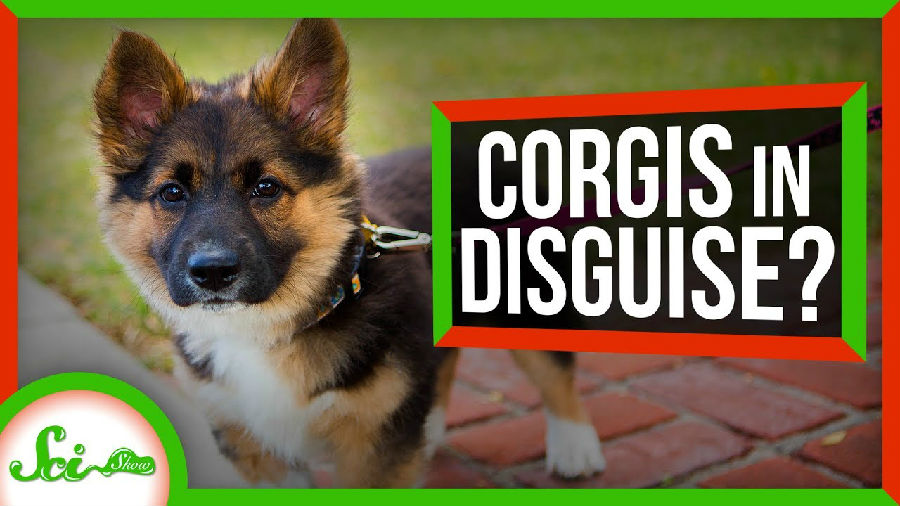Thanks to Brilliant for supporting this episode of SciShow! Go to Brilliant.org/SciShow to learn more.
感谢Brilliant对本期节目的支持!前往Brilliant.org/SciShow了解更多。
You might have noticed that a lot of corgi mixes look exactly like a corgi in a costume of a different dog breed.
你可能已经注意到,许多柯基混血看起来就像穿着不同犬种服装的柯基。
The Internet certainly has. Go pull up some pictures. We'll wait.
网上当然有很多照片。可以去看看。
No matter what, though, something about these pups always screams "corgi". It's the stumpy legs that gives them away.
不管怎样,这些小狗总是有会让人尖叫“柯基”的特征—是粗粗的小短腿暴露了它们。
Those legs aren't just a coincidence, though. They're actually the product of thousands of years of breeding. Or inbreeding.
这些小短腿并非巧合,它们其实是数千年繁殖的产物,或近亲繁殖。
And those little legs come from a funky mutant gene that's been passed down the whole way.
这些小短腿来自于一种特别的突变基因,并被保留了下来。
Every corgi carries genes for dwarfism. And purebred corgis have been bred to make sure that trait gets passed on every time.
每只柯基犬都携带侏儒症的基因。纯种柯基犬的培育是为了确保这种特性每次都能传递下去。
But when corgis breed with other dogs, their pups often have those same little legs, because that gene is dominant
但当柯基犬和其他狗狗交配时,它们的幼犬通常都有同样的小腿,因为这种基因是显性的
so even if a dog has only one copy of the gene, short legs will win out. Except that's not the whole story.
因此即使一只狗只有一个基因副本,小短腿们也会胜出。但这还不是故事的全部。
In corgis, dwarfism isn't caused by any old gene. It's caused by a mutant gene called a retrogene.
在柯基犬中,侏儒症不是由任何旧基因引起的,而是由一种叫做逆基因的突变基因引起的。
A retrogene forms when the usual system for building proteins doesn't go as planned.
当构建蛋白质的通常系统没有按计划进行时,逆基因就形成了。
In a normal case, a gene, made of DNA, is transcribed into a molecule called messenger RNA, or mRNA.
在正常情况中,一个由DNA组成的基因被转成一个叫做信使核糖核酸(mRNA)的分子。
The cell then interprets that code and uses it as an instruction manual to build a protein. Which usually works great!
然后,细胞对这些密码进行解释,并将其用作制造蛋白质的说明书。这通常很有效!
Except, in rare cases, that mRNA code which is only supposed to act as a messenger gets converted back into DNA.
除了,在少数情况中,mRNA密码仅充当了重新转换成DNA的信使。
And in even rarer cases, that converted DNA manages to slip back into the genome in a different place.
并且在更加罕见的情况下,被转换的DNA会设法溜回不同地方的基因组中。

Usually that gene doesn't do anything; it just sits there.
通常那个基因什么都不做,只是坐在那里。
But under special circumstances, that duplicated gene can even produce proteins.
但在特殊情况下,这种复制的基因甚至可以产生蛋白质。
That's exactly what's happening with the short-legged dog imposters.
冒牌小短腿们就是这种情况。
Multiple genes can cause dwarfism in dogs, but in corgis, and corgi mixes, dwarfism is caused by a retrogene.
多基因会导致狗狗患上侏儒症,但在柯基和柯基混交犬中,侏儒症是由逆基因引起的。
Specifically, there are multiple retrogenes derived from a gene called FGF4.
具体来说,有多个逆基因来自一个叫FGF4的基因。
It codes for a type of protein called a growth factor that tells the body's cells how to grow.
它编码一种叫做生长因子的蛋白质,这种蛋白质告诉身体细胞如何生长。
And that's a normal gene that all dogs have on chromosome 18.
这是所有狗的18号染色体上的正常基因。
But it's become a retrogene and copied itself back into the genome -- more than once.
但它已经成为一个逆基因,并将自己复制回了基因组中且不止一次。
There's one of these retrogenes on chromosome 12, and one on chromosome 18.
12号染色体上有一个逆基因,18号染色体上也有一个。
Either one is enough to cause dwarfism in dogs. But some really stumpy breeds -- like corgis and dachshunds -- have both.
任何一种情况都足以引起狗的侏儒症。但有些矮胖的品种,如柯基犬和腊肠犬,两种情况同存。
Scientists think that the expression of these extra growth factors may alter the dogs' development.
科学家们认为这些额外生长因子的表达可能会改变狗的发育。
In fact, similar genetic changes are linked with dwarfism in humans.
事实上,类似的基因变化也与人类的侏儒症有关。
In short-legged dogs, the extra FGF4 tells limbs to stop growing early,
在短腿狗中,额外的FGF4提前告诉四肢停止生长,
so the ends of their bones harden, and you end up with a regular-sized dog with stubby legs.
所以它们的骨头末端会变硬,最后你就会得到一条大小正常,但腿很粗短的狗。
And many breeds, from Pekingese to basset hounds, have short legs for similar reasons! That tells us two things.
很多品种,如北京哈巴狗以及矮腿猎犬,都因类似的原因而长了小短腿!这告诉我们两件事。
One, this mutation appeared a really long time ago, back in the early days of domesticating dogs.
一,这种突变出现在很久以前,早在驯化狗的早期。
And two, humans throughout history have found this trait so attractive that they bred these waddly dogs into existence all around the world.
二,纵观历史,人类发现这种特性非常吸引人,所以他们在世界各地培育了这些步子摇摆的狗。
The cuteness is not without its downsides, though.
不过,这种可爱也有它的缺点。
The same retrogene that gives dogs their adorable waddle is also linked with spinal disease
赋予狗狗们蹒跚步伐的同种逆基因也和脊椎疾病有关
that can cause pain and neurological damage, which scientists are still trying to understand.
这种疾病会导致疼痛和神经学损伤,科学家们仍在试图对这一点进行理解。
So next time you see one of those dogs in a corgi-shaped package, remember it's because humans have a soft spot for those little,
所以下一次你看到柯基体型的狗狗,记住,这是因为人类对娇小、
furry mutants and probably have ever since our long friendship with dogs began.
毛绒绒突变体的喜爱,并且这种喜爱也许是自我们与狗的长期友谊而起。
Now that you've had your dose of cute internet dogs, if you're up for a challenge, you could head over to Brilliant.org.
现在你已经对可爱的网红狗狗有所了解,如果你想挑战一下,你可以去Brilliant.org。
Brilliant offers Daily Challenges, which are questions about science concepts that challenge you to exercise your mind every day.
Brilliant提供每日挑战,这些挑战是关于科学概念的,让你每天都能锻炼你的思维。
Brilliant believes effective learning is about problem solving, and these challenges will help you get practice.
Brilliant相信有效的学习是解决问题,这些挑战将帮助你得到实践。
New challenges go up every day, and they're free to do,
每天都会有新挑战,而且是免费的,
but if you sign up to become a Premium member, you can access to the entire archive.
但如果你注册成为会员,就可以回顾往期所有挑战。
And if you want more, every challenge is associated with a course where you can explore the same topic in more detail.
如果这还不够,那么每日挑战都有一期相关课程,你可以通过课程了解更多细节。
If you're one of the first 200 SciShow viewers to sign up at Brilliant.org/SciShow, you'll get 20% off an annual Premium subscription.
前200名登录brilliant.org/scishow.com《科学秀》观众,将获得20%的年费优惠。
And by checking it out, you'll be supporting SciShow too—so thanks for that!
点查看,也是在支持我们的节目—所以感谢大家!











